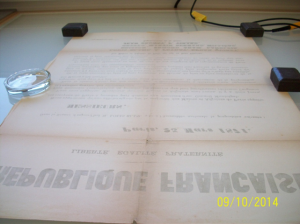Behind the Scenes in Conservation: the Paris Commune Documents by Emma Johnson
Oct
24
From 18th-28th March 1871, French insurgents rebelled against the French Government and took over the city of Paris. The French citizens called for ‘liberte, egalite and fraternite’ against, what they believed to be, a corrupt government. I have been working on some of the posters that were used to incite rebellion against the Government; the University of Sussex Special Collections has the largest collection of these documents outside of France.
The first stage in the process of conservation was to surface clean each document. I have undertaken this process before on an 1805 survey map made of parchment and could be fairly vigorous due to the nature of the material. The Paris Commune documents, on the other hand, are incredibly fragile and were printed on thin paper; they were not designed to last a great length of time. Many also have rips and tears, particularly around the edges or within the centre of the paper due to where many of them had been kept folded in half.
The equipment I used for this process was a Mars Staedtler eraser and a chemical sponge. It was also important to weight each document correctly on particularly vulnerable areas such as rips and tears, to ensure that the document was still and stable during cleaning. I found that I had to use the eraser with care as the paper was very fragile. However, using the chemical sponge also posed difficulties as the text on some posters appeared fugitive when using the dab and twist method to lift the surface dirt. I took extra care when treating documents that had large sections of ink.
It is important to document your work when conserving documents so that you can see the condition of the document when it arrives in the workshop and the work that the conservator has then carried out.
The next stage was to repair any rips and tears on the documents. This was achieved by using a hot tacking iron and tissue paper lined with adhesive that activates when heat is applied. Large repairs are applied to the verso (back) of the document, so as not to obscure any text. If repairs are made to the recto (front) of the document, the repair is generally made no larger than 5mm from the rip or tear, generally for aesthetic reasons.


